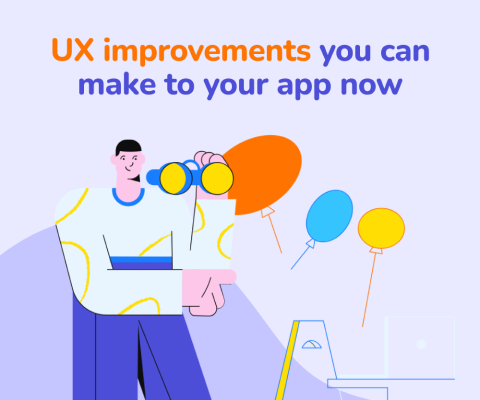December 17th, 2025, posted in for_founders
by Adelina
In the last few years, ride-sharing apps have revolutionized urban mobility, giving users easy access to transportation services with just a few taps on their smartphones. However, not every one of them is made similarly. While some do a great job of offering an effortless straightforward user experience, others fall short and leave users feeling angry and unsatisfied.
Love it or not, in 2024 customer experience plays a huge role in the success of apps and it can greatly affect the sales and success of the businesses. We'll look into how strategic UX design can improve customer satisfaction and revenue growth in the transportation sector, from simplifying the booking process to integrating loyalty programs and personalizing the interaction of the customer.
Now let's get started and look into this intricate relationship between user-centric design and transit apps.
What is a ride-sharing app and what isn't
Our ability to navigate cities has been completely changed by mobility apps. They serve as digital booking centers for a variety of transportation options, including ride-sharing and taxis.
Unlike traditional transportation services, these apps offer a smooth experience with features like live tracking, effortless payments, and customized interactions. They are a combination of technology and convenience that are changing the way we travel, while improving our urban mobility experience.
Modern apps, in comparison to traditional transportation services, provide ease of use, efficiency, and safety thanks to the use of technologies like GPS tracking and data analytics.
The challenges the market faces
As you expect, the more ride-sharing apps there are, the more challenges appear, from the run for market supremacy to the constant dedication to fulfilling customer needs.
A significant challenge that the providers face is being distinctive in a crowded market. Companies such as Uber and Lyft, for example, have been rivals in the race for the crown. To show they are worthy, these companies used a variety of strategies, including creative marketing campaigns, strategic partnerships, and service diversity.
Another challenge worth mentioning is to guarantee security and safety. Users expect strong measures to protect their personal data and guarantee their safety during rides. Businesses such as Bolt and Ola have added strict security measures and safety features like SOS buttons and real-time ride tracking. However, keeping a balance between security measures and a great experience for the user remains an ongoing challenge for the mobility app providers.
A different struggle is being able to adapt to changing user preferences. Users are looking for more convenient and environmentally friendly alternatives to traditional forms of transportation, proof being the rising popularity of electric bikes and scooters. In order to meet these changing needs, the companies have to constantly reinvent themselves and expand their product offerings.
How to start
To guarantee success in the extremely competitive market, developing an app requires careful planning and execution.
Define the purpose of your app
It's essential to figure out the purpose of your app before launching it into development. Provide a clear description of its goals, identifying which audience it hopes to reach. Having a very clear purpose will help your app succeed, whether it's to ease everyday commutes, provide upscale travel experiences, or target particular niche markets.
Analyze the market
A solid understanding of the market will be necessary for success in a competitive space. Do in-depth market research to learn about current competitors, identify new trends, and explore hidden opportunities. Finding market gaps and customer pain points will allow you to customize your app's features for the best impact.
Choose a monetization model
The foundation of any successful ride-sharing app business is revenue generation. Look at a variety of revenue streams, from conventional ride fees and subscriptions to innovative approaches like in-app partnerships and advertising. Choose a model that ensures long-term profitability while fitting in with the value proposition of your app and connecting with your target market.
Choose an experienced technical partner
Every successful ride-sharing app has a competent technical partner who can turn concepts to life. Work together with seasoned development teams that have the knowledge and experience needed to handle all aspects of app development. Look for partners who are dedicated to providing excellence, who understand the nuances of your industry, and who share your vision.
The process
As you hop on the journey of creating a great transportation app, it's essential that you stick to a clear process that prioritizes user needs and experiences. Here is a detailed explanation of each step involved:
Empathize
Get to know your users, drivers, and admins on a deep level so that you can genuinely understand their needs, struggles, and goals. Resonating with their points of view will help you get useful information that will guide the direction of your app.
Conduct surveys
Use surveys to reach out to a broad audience and get their opinions. These surveys provide essential data that can direct the design and functionality of your app by assessing user preferences, behaviors, and pain points.
Conduct interviews
Expand on the discussion by conducting in-depth interviews with administrators, drivers, and users, among other important stakeholders. These interviews provide a free environment for questions and answers, giving you an immediate understanding of their needs, goals, and problems.
The framework
Now that you have the knowledge from your surveys and empathy-building activities, it's time to put together a solid framework for the design of your app. This framework acts as the architectural blueprint for your app, taking into account user input, industry best practices, and your own vision.
User journey map
Map out the user journey from start to finish, charting each interaction and touchpoint along the way. You can ensure a smooth and simple use of the app by identifying pain points and areas for improvement by visualizing the user's journey through your app.
Ideate
Bring a solid understanding of user needs and pain points to the ideation phase. Brainstorm to find creative features and innovative solutions to address these challenges head-on and provide users with distinctive and memorable experiences.
Usability tests
Now that you have prototypes, it's time to put your design to test by conducting user testing. Use actual users in the testing sessions to get real feedback, confirm design choices, and identify any potential constraints or functionality problems.
 Source: Unsplash
Source: Unsplash
The 3 sides of a transportation app
There are 3 sides in the complicated univers of transit apps, each playing its role in ensuring the best and most effective user journey.
Customer Side
The user is the firestarter of the app, whose part begins the moment he presses a button. The user interface for the customer side has to be more than just a way to book rides. It also has to offer satisfaction and happiness to the customer, in order to provide a positive experience.
All interactions should be designed with the comfort and convenience of the customer in mind, from simple booking procedures and clear pricing to customized suggestions based on personal tastes.
Driver Side
Even though the spotlights are usually on the customers, you must not forget about drivers. While carefully and effectively bringing passengers to their destinations, drivers are an important gear of the transportation ecosystem.
The driver side of a public transportation app needs to have user-friendly interfaces that make bookings and navigation intuitive and simple in order to assist drivers in their roles. To improve the driving experience you have to include features like real-time traffic updates, optimized navigation, and tools for managing earnings and schedules.
Admin Panel
Admins have access to a wide variety of data and insights that facilitate informed choices and efficient operations. The admin panel works as the hub of the application, providing administrators features for real-time app performance monitoring, extensive analytics, and tools for managing drivers and users.
This side of the app offers administrators the necessary tools to guide the application towards success, including tracking key performance indicators to maximizing the efficiency of operations.
How to drive revenue growth
Streamline the booking system
Improving the booking process has a big influence on generating income. Transit apps may encourage users to book more rides by streamlining processes, removing extra fields, and adding features like saved preferences and quick booking options.
For example, Uber's user-friendly interface, quick access to ride options, and simplified booking process have all helped to drive the company's revenue growth and popularity.
Integrate loyalty programs
These are an effective way to increase revenue growth and customer retention. Commute apps can encourage users to keep using their services by rewarding them with discounts, rides, and special benefits.
For example, Lyft's rewards program, Lyft Rewards, gives users points for each dollar spent on rides. These points can then be exchanged for extra advantages or future rides, which encourages customer loyalty and increases revenue.
Personalize the experience
For mobility apps, personalization is needed to increase user engagement and revenue growth. Apps are able to provide recommendations, promotions, and content that are customized to the interests and behaviors of individual users by using user data and preferences.
For instance, Uber's customized search recommendations and listings, based on users' past bookings and preferences, helped the platform to increase its bookings and revenue.
Tips & tricks for driving revenue with great UX
User centric design: the foundation for revenue growth
Put the needs and preferences of your users first when designing your app. Public transportation apps can stand out in the market and inspire user loyalty by understanding the needs and pain points of their users and creating simple, fun interactions.
For instance, Google Maps constantly modifies its features and UI in response to user input, guaranteeing that the application remains simple to use and intuitive for millions of users across the globe.
Cross platform consistency and accessibility
A smooth user experience depends on accessibility and consistency. The apps should prioritize consistency on the user interface. Pay attention to design elements, navigation patterns, and feature availability across various platforms and devices.
Lyft's website and mobile app have the same branding and UI components, so users will always have a familiar experience regardless of the platform they use.
Collaborative efforts between UX teams, marketing teams, customer success teams, and development teams
A successful and effective mobility app needs cooperation between UI designers, marketers, and developers. Transportation companies can guarantee similar goals, priorities, and strategies by encouraging communication and collaboration amongst these teams. This will ultimately result in a more consistent and impactful user experience.
Uber's cross-functional teams collaborate to evaluate user input, pinpoint issues, and enhance the user experience on the app.
Post launch UX evaluation and continuous improvement
The journey of achieving a great experience for the user doesn't end after the app is launched. This is an ongoing process, including constant review and development. After launch, transit apps should collect user feedback, examine usage statistics, and conduct testing to find areas that need work and refine the features and design.
Transportation companies can maintain their app's relevance, competitiveness, and user value over time by consistently gathering feedback from users and making design iterations. For instance, Waze updates its app frequently based on feedback from users and usage statistics, adding new features and enhancements to improve user experience and increase engagement.
Investing in user experience innovations means more than just improving the interface of an app. It's about finding the secret to long-term success and revenue growth. Transportation companies can differentiate themselves from competitors and create new opportunities for growth and success by putting the needs of drivers, customers, and administrators first.
Are you ready to use great design services to take your transportation app to new heights? Don't miss out the chance to turn your app into a revenue-generating machine. Book a free meeting with us and learn more about the potential improvements for your company.


















